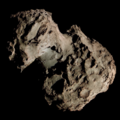C/1964 N1 (Ikeya)
In today's world, C/1964 N1 (Ikeya) is a topic that has captured the attention of millions of people around the world. Since its emergence, C/1964 N1 (Ikeya) has been the subject of debate, analysis and study by experts in different fields. Its impact on society, the economy, politics and culture make it a topic of universal relevance. In this article, we will explore the various facets of C/1964 N1 (Ikeya), from its origins to its influence on people's daily lives. Through an exhaustive analysis, we will seek to shed light on the different aspects that make C/1964 N1 (Ikeya) a topic worthy of study and interest.
 Comet Ikeya (1964f) photographed by Dennis Milon on 27 July 1964 | |
| Discovery | |
|---|---|
| Discovered by | Kaoru Ikeya |
| Discovery date | 3 July 1964 |
| Designations | |
| 1964f | |
| Orbital characteristics[1] | |
| Epoch | 1964-Jul-28.0 |
| Observation arc | 56 days |
| Number of observations | 36 |
| Aphelion | 110.97 AU |
| Perihelion | 0.822 AU |
| Semi-major axis | 55.90 AU |
| Eccentricity | 0.9853 |
| Orbital period | 418 years |
| Inclination | 171.92° |
| 269.95° | |
| Argument of periapsis | 290.77° |
| Last perihelion | 1 August 1964 |
| Earth MOID | 0.041 AU |
| Jupiter MOID | 0.267 AU |
| Physical characteristics | |
| Comet nuclear magnitude (M2) | 16.0 |
| 2.7 (1964 apparition) | |
C/1964 N1 (Ikeya), also known as Comet 1964f, is a long-period comet discovered by Kaoru Ikeya on 3 July 1964. The comet last passed perihelion on 1 August 1964, when it reached an apparent magnitude of 2.7.[2]
Observational history
The comet was discovered by the Japanese amateur astronomer Kaoru Ikeya on 3 July 1964. It was the second comet discovered by Kaoru Ikeya, after C/1963 A1. The comet was located in the morning sky, in the constellation of Taurus, at the star cluster Hyades, and had an estimated apparent magnitude of 8. The comet was moving southeast.[3]
The comet brightened during July and was observed with the naked eye on July 19 by Jim Young from the Table Mountain Observatory. It reached perihelion on 1 August 1964. By 6 August it was visible by naked eye while it passed 1-2° from Rigel. After that it was difficult to observe, being located in the morning twilight. The closest approach to Earth was on August 12, at a distance of about 0.2 AU (30 million km; 19 million mi) and at a solar elongation of 31°. On August 15 the comet was reported by S. Archer from Australia to have a magnitude of 2.8 and its tail to be 4.5 degrees long. The comet became visible from the northern hemisphere in the evening sky in late August, located low, near the horizon, and had faded noticeably.[4][5]
On 2 September the comet was estimated to have a magnitude of 6.5 and by 12 September it was 8.5. The comet was last detected on 7 October 1964, when it had a magnitude of 10.4.[6]
Scientific results
The spectrum of the comet was obtained on 29 and 30 July by the Mount Wilson Observatory and photoelectric measurements made it possible to measure the relative abundances. The spectrum revealed the presence of C2, C3, CH, and CN. The N(CH)/N(CN) and N(C3)/N(CN) were both about 0.3 in the coma near the cometary nucleus.[7]
Meteor showers
The comet is considered to be the parent body of a number of meteor showers, as it has been modeled to create four streams that intersect with the orbit of Earth. The first meteor shower to be associated with C/1964 N1 (Ikeya) is the July ξ Arietids.[8] The comet is also considered to be the parent of body of the meteor shower ϵ-Geminids and it is also possible that it could be the parent body of ξ-Geminids. All these showers are diffuse and have few meteors.[9]
References
- ^ "Small-Body Database Lookup: C/1964 N1 (Ikeya)". ssd.jpl.nasa.gov.
- ^ "Brightest comets seen since 1935". www.icq.eps.harvard.edu. Retrieved 9 March 2023.
- ^ Roemer, Elizabeth (August 1964). "COMET NOTES". Publications of the Astronomical Society of the Pacific. 76 (451): 262–265. doi:10.1086/128098. ISSN 0004-6280. JSTOR 40674156. S2CID 250807386.
- ^ Roemer, Elizabeth (October 1964). "COMET NOTES". Publications of the Astronomical Society of the Pacific. 76 (452): 358–361. doi:10.1086/128114. ISSN 0004-6280. JSTOR 40676862. S2CID 250884644.
- ^ Milon, D. (1 December 1965). "A.L.P.O. Comets Section Report: Comet Ikeya 1964f". Strolling Astronomer. 19 (3–4): 37–41. Bibcode:1965StAst..19...37M.
- ^ Kronk, Gary W.; Meyer, Maik; Seargent, David Allan John (11 November 2010). Cometography: Volume 5, 1960-1982: A Catalog of Comets. Cambridge University Press. pp. 123–125. ISBN 978-0-521-87226-3.
- ^ Kovar, N. A.; Kovar, R. P. (October 1965). "Photoelectric Measurements of Comet Ikeya 1964f". The Astrophysical Journal. 142: 1191. doi:10.1086/148388.
- ^ Šegon, Damir; Vaubaillon, Jérémie; Gural, Peter S.; Vida, Denis; Andreić, Željko; Korlević, Korado; Skokić, Ivica (February 2017). "Dynamical modeling validation of parent bodies associated with newly discovered CMN meteor showers". Astronomy & Astrophysics. 598: A15. arXiv:1611.02297. doi:10.1051/0004-6361/201629100. S2CID 119256599.
- ^ Neslušan, L.; Hajduková, M. (August 2018). "Meteor showers of comet C/1964 N1 (Ikeya)". Astronomy & Astrophysics. 616: A162. doi:10.1051/0004-6361/201832829. S2CID 125829636.

